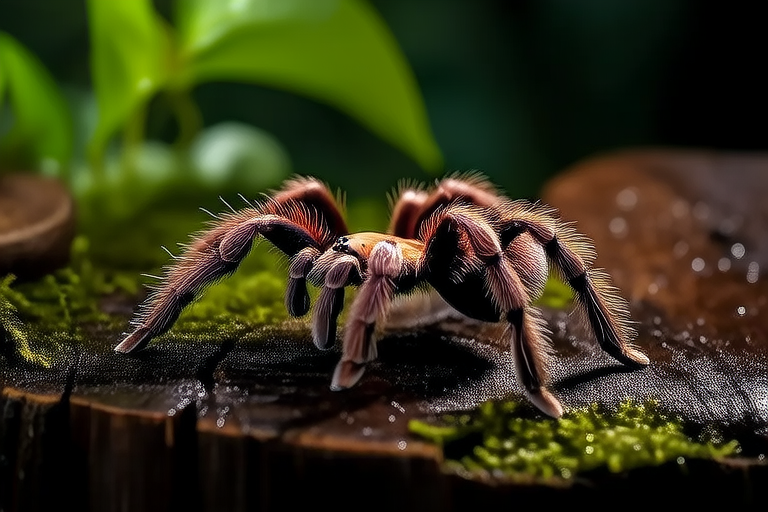Unraveling the Mystique of the Chilean Rose Tarantula: A Beginner’s Guide
Welcome to the fascinating world of tarantulas! The Chilean Rose Tarantula, also known as Grammostola rosea, is one of the most popular pet tarantulas due to its docile nature and ease of care. This guide will help you understand everything from its natural habitat to housing requirements, dispelling common myths and providing essential tips for handling.
The Natural Habitat of the Chilean Rose Tarantula
Native to the deserts and scrublands of Chile, Argentina, and Bolivia, the Chilean Rose Tarantula thrives in arid environments with temperatures ranging from 75°F to 85°F (24°C to 29°C) during the day and cooler at night. They prefer burrowing into sandy or rocky soil where they can hide from predators and the harsh sun. These conditions mimic their natural habitat, making it easier for owners to recreate them.
Dietary Needs of the Chilean Rose Tarantula
These spiders are carnivorous, feeding primarily on insects such as crickets, mealworms, and occasional small mice. In captivity, you can feed your tarantula once every one to two weeks. It’s important to ensure that prey items are appropriately sized; too large, and the spider may struggle to digest it properly. Gut-loading the prey—feeding nutritious food to the prey before offering it to your tarantula—can enhance the nutritional value of each meal.
Housing Requirements for Your Chilean Rose Tarantula
A suitable enclosure for a Chilean Rose Tarantula should be spacious enough for the spider to move around comfortably but not so large that it becomes difficult to manage. A general rule of thumb is an enclosure that is three times the leg span of the tarantula in length and width. A height of about two-thirds of the length is sufficient. Substrate should be at least four inches deep to allow for burrowing, which is crucial for their comfort and well-being.
Proper ventilation is also key, so make sure there are adequate air holes without compromising the humidity level within the tank. Humidity levels should be maintained between 60% and 80%, which can be achieved through regular misting and the use of water dishes.
Common Behaviors of the Chilean Rose Tarantula
Chilean Rose Tarantulas are generally calm and slow-moving creatures, making them ideal pets for beginners. They spend much of their time hiding or resting in their burrows. However, they do exhibit some interesting behaviors:
- Defensive Behavior: When threatened, these tarantulas might lift their front legs and abdomen in a posture known as ‘threatening pose.’ While intimidating, this behavior rarely leads to biting unless provoked.
- Molting: Tarantulas molt periodically to shed their exoskeleton. During this process, they become extremely vulnerable and should not be disturbed. Provide a humid environment to aid in successful molting.
- Burrowing: As mentioned earlier, burrowing is essential for their comfort. Ensure that substrate is available for digging.
Tips for Handling Your Chilean Rose Tarantula
Handling your tarantula should always be done carefully to avoid stressing the animal. Here are some tips:
- Use a Container: Always transfer your tarantula using a plastic container rather than picking it up directly with your hands.
- Be Gentle: Avoid sudden movements and handle the spider gently.
- Observe Before Handling: Get to know your tarantula’s behavior patterns and only handle when necessary.
Dispelling Myths About Tarantulas
One of the most common misconceptions about tarantulas is that they are aggressive and dangerous. In reality, Chilean Rose Tarantulas are quite docile and rarely bite unless severely provoked. Another myth is that all tarantulas are venomous. While true, their venom is generally not harmful to humans and more akin to a bee sting in terms of severity.
Differences Between the Chilean Rose Tarantula and Other Species
Compared to other tarantula species, the Chilean Rose Tarantula stands out due to its relatively small size, manageable temperament, and ease of care. For instance, the Brazilian Black Tarantula is larger and more aggressive, while the Mexican Red Knee Tarantula has a striking appearance but requires more specific care. The Chilean Rose Tarantula offers a perfect balance for those new to tarantula ownership.
Advice for New Owners
Starting with a Chilean Rose Tarantula is an excellent choice for beginners interested in exotic pets. Remember to research thoroughly before bringing one home, ensuring you have all necessary supplies and knowledge to provide the best care possible. Regular observation and maintenance of their environment will keep your tarantula healthy and happy.
By understanding the unique characteristics and needs of the Chilean Rose Tarantula, you’re setting yourself up for a rewarding experience with these fascinating creatures. Enjoy exploring the mysteries of your new pet!
